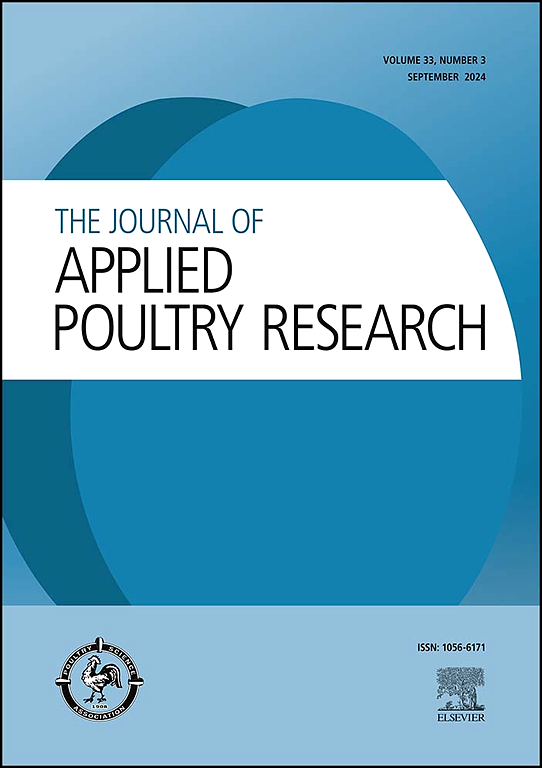美国马里兰州下东岸养殖鸡中沙门氏菌的流行及耐药性分析
IF 2
3区 农林科学
Q2 AGRICULTURE, DAIRY & ANIMAL SCIENCE
引用次数: 0
摘要
人们对有机、新鲜和本地采购的家禽日益增长的兴趣导致了后院家禽养殖的扩大。然而,最近与后院家禽有关的沙门氏菌爆发引起了重大的公共卫生关注。在这项研究中,我们调查了后院家禽沙门氏菌的患病率、血清型和抗生素耐药性,这是马里兰大学东部推广部4-H项目青年发展倡议的一部分。我们将一天大的罗斯小鸡分发给马里兰州下东海岸威科米科、萨默塞特和伍斯特县的参与者,用于实践学习、管理和微生物采样。在研究期间,从三个4-H参与农场和家禽加工厂共收集了82份样本,包括粪拭子、垃圾、环境海绵、饲料和整个尸体。采用标准微生物学技术对样品进行处理,并采用针对invA基因的PCR方法对分离的沙门氏菌进行鉴定。共检出沙门氏菌13株,其中包括婴儿沙门氏菌(7/13)(1)。采前样品中沙门氏菌患病率为6.75%(5/74),采后样品中沙门氏菌患病率为100%(8/8)。所有13株分离株均具有多重耐药(MDR),表现出对几种抗生素的耐药,包括青霉素类、大环内酯类和四环素类。本研究强调了耐抗生素沙门氏菌在后院家禽中的流行,并强调需要采取严格的生物安全措施、适当的卫生和教育,以防止人畜共患疾病的传播,特别是在作为后院鸡的主要处理者的儿童中,从而促进公共卫生和食品安全。本文章由计算机程序翻译,如有差异,请以英文原文为准。
Prevalence and antimicrobial resistance of salmonella isolates from backyard chicken in Maryland lower eastern shore, USA
The growing interest in organic, fresh, and locally sourced poultry leads to the expansion of backyard poultry farming. However, recent backyard poultry-linked Salmonella outbreaks have raised significant public health concerns. In this study, we investigated the prevalence, serotype, and antibiotic resistance of Salmonella from backyard poultry as part of a youth development initiative by the University of Maryland Eastern Extension Department's 4-H program. We distributed day-old Ross chicks to participants across Wicomico, Somerset, and Worcester counties in lower Eastern Shore, MD, for hands-on learning, management, and microbiological sampling. A total of 82 samples, including cloacal swabs, litter, environmental sponges, feed, and whole carcasses, were collected from three 4-H participant farms and the poultry processing plant during the study period. Samples were processed using standard microbiological techniques, and Salmonella isolates were confirmed by PCR targeting the invA gene. A total of 13 Salmonella isolates were identified, including S. Infantis (7/13) (1). The prevalence of Salmonella in pre-harvest samples was 6.75 % (5/74), whereas post-harvest samples exhibited a 100 % prevalence (8/8). All 13 isolates were multidrug-resistant (MDR), exhibiting resistance to several antibiotic classes, including penicillins, macrolides, and tetracyclines. This study highlights the prevalence of antibiotic-resistant Salmonella in backyard poultry and stresses the need for strict biosecurity measures, proper hygiene, and education to prevent zoonotic transmission, particularly among children who are the major handlers of backyard chicken thereby promoting public health and food safety.
求助全文
通过发布文献求助,成功后即可免费获取论文全文。
去求助
来源期刊

Journal of Applied Poultry Research
农林科学-奶制品与动物科学
CiteScore
4.10
自引率
10.50%
发文量
80
审稿时长
104 days
期刊介绍:
The Journal of Applied Poultry Research (JAPR) publishes original research reports, field reports, and reviews on breeding, hatching, health and disease, layer management, meat bird processing and products, meat bird management, microbiology, food safety, nutrition, environment, sanitation, welfare, and economics. As of January 2020, JAPR will become an Open Access journal with no subscription charges, meaning authors who publish here can make their research immediately, permanently, and freely accessible worldwide while retaining copyright to their work. Papers submitted for publication after October 1, 2019 will be published as Open Access papers.
The readers of JAPR are in education, extension, industry, and government, including research, teaching, administration, veterinary medicine, management, production, quality assurance, product development, and technical services. Nutritionists, breeder flock supervisors, production managers, microbiologists, laboratory personnel, food safety and sanitation managers, poultry processing managers, feed manufacturers, and egg producers use JAPR to keep up with current applied poultry research.
 求助内容:
求助内容: 应助结果提醒方式:
应助结果提醒方式:


